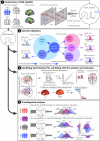Generalizable and transportable resting-state neural signatures characterized by functional networks, neurotransmitters, and clinical symptoms in autism
- PMID: 39342041
- PMCID: PMC11919695
- DOI: 10.1038/s41380-024-02759-3
Generalizable and transportable resting-state neural signatures characterized by functional networks, neurotransmitters, and clinical symptoms in autism
Abstract
Autism spectrum disorder (ASD) is a lifelong condition with elusive biological mechanisms. The complexity of factors, including inter-site and developmental differences, hinders the development of a generalizable neuroimaging classifier for ASD. Here, we developed a classifier for ASD using a large-scale, multisite resting-state fMRI dataset of 730 Japanese adults, aiming to capture neural signatures that reflect pathophysiology at the functional network level, neurotransmitters, and clinical symptoms of the autistic brain. Our adult ASD classifier was successfully generalized to adults in the United States, Belgium, and Japan. The classifier further demonstrated its successful transportability to children and adolescents. The classifier contained 141 functional connections (FCs) that were important for discriminating individuals with ASD from typically developing controls. These FCs and their terminal brain regions were associated with difficulties in social interaction and dopamine and serotonin, respectively. Finally, we mapped attention-deficit/hyperactivity disorder (ADHD), schizophrenia (SCZ), and major depressive disorder (MDD) onto the biological axis defined by the ASD classifier. ADHD and SCZ, but not MDD, were located proximate to ASD on the biological dimensions. Our results revealed functional signatures of the ASD brain, grounded in molecular characteristics and clinical symptoms, achieving generalizability and transportability applicable to the evaluation of the biological continuity of related diseases.
© 2024. The Author(s).
Conflict of interest statement
Competing interests: MK is an inventor of patents owned by the Advanced Telecommunications Research Institute International related to the present work (PCT/JP2014/061544 [WO2014178323] and JP2015-228970/6195329). AY and MK are inventors of a patent application submitted by the Advanced Telecommunications Research Institute International related to the present work (JP2018-192842). YT is an employee of SHIONOGI & CO., LTD. YS and MK are employees of XNef Inc.
Figures






Update of
-
Generalizable neuromarker for autism spectrum disorder across imaging sites and developmental stages: A multi-site study.Res Sq [Preprint]. 2023 May 15:rs.3.rs-2853362. doi: 10.21203/rs.3.rs-2853362/v1. Res Sq. 2023. Update in: Mol Psychiatry. 2025 Apr;30(4):1466-1478. doi: 10.1038/s41380-024-02759-3. PMID: 37292656 Free PMC article. Updated. Preprint.
References
-
- Floris DL, Peng H, Warrier V, Lombardo MV, Pretzsch CM, Moreau C, et al. The link between autism and sex-related neuroanatomy, and associated cognition and gene expression. Am J Psychiatry. 2022;180:50–64. appiajp20220194 - PubMed
MeSH terms
Substances
Grants and funding
- JP19dm0207069/Japan Agency for Medical Research and Development (AMED)
- JP21H05174/MEXT | Japan Society for the Promotion of Science (JSPS)
- JP18dm0307001/Japan Agency for Medical Research and Development (AMED)
- JP18dm0307009/Japan Agency for Medical Research and Development (AMED)
- R21 MH107045/MH/NIMH NIH HHS/United States
- JP21H05171/MEXT | Japan Society for the Promotion of Science (JSPS)
- JP18dm0307008/Japan Agency for Medical Research and Development (AMED)
- JP24wm0625502/Japan Agency for Medical Research and Development (AMED)
- R03 MH096321/MH/NIMH NIH HHS/United States
- JP23wm0625001/Japan Agency for Medical Research and Development (AMED)
- K23 MH087770/MH/NIMH NIH HHS/United States
- JP18dm0307004/Japan Agency for Medical Research and Development (AMED)
LinkOut - more resources
Full Text Sources
Medical

